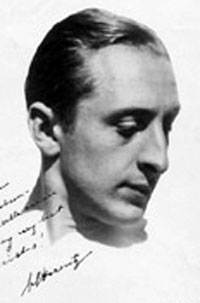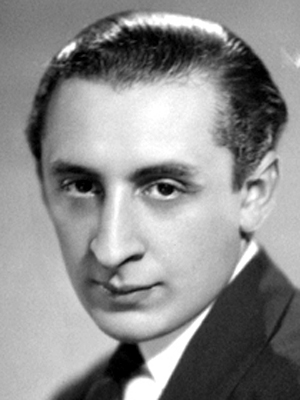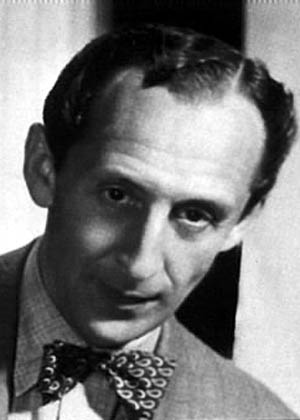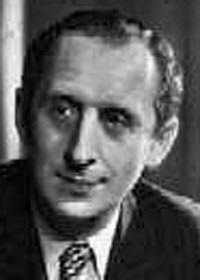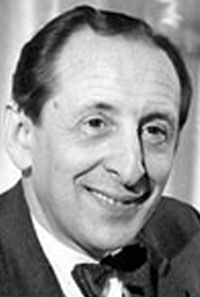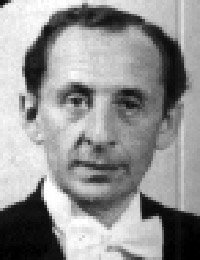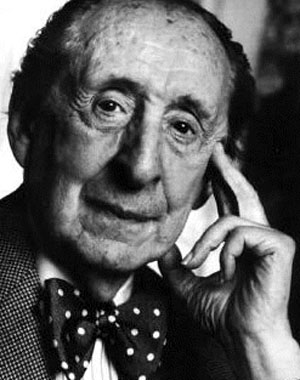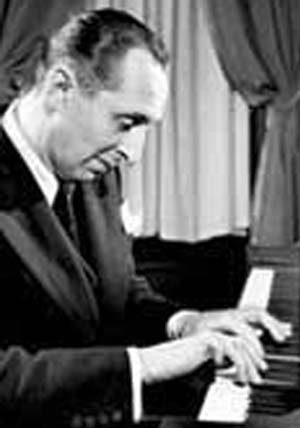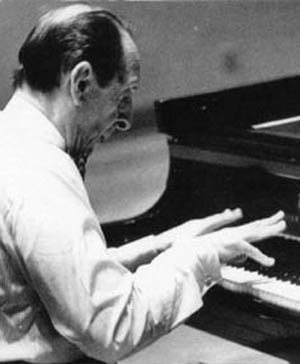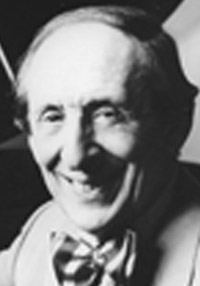Copyright Michael D. Robbins 2005
Astro-Rayological Interpretation & Charts
Quotes
Biography
Images and Physiognomic Interpretation
Insert Interpretation & Charts
born Oct. 1 [Sept. 18, Old Style], 1903, Berdichev, Russia [now in Ukraine]
died Nov. 5, 1989, New York, N.Y., U.S.
I must tell you I take terrible risks. Because my playing is very clear, when I make a mistake you hear it. If you want me to play only the notes without any specific dynamics, I will never make one mistake. Never be afraid to dare.
My future is in my past and my past is my present. I must now make the present my future.
ATTRIBUTION: On resuming concert career after 12-year retirement, NY Times 17 Mar 65Perfection itself is imperfection.
ATTRIBUTION: Defending false notes, Newsweek 17 May 65I am a general. My soldiers are the keys and I have to command them.
My face is my passport.
ATTRIBUTION: To Soviet official on visit to USSR, Time 28 Apr 86“Your mind must control, but you must have heart . . . . Give your feeling free.”
“Played percussively, the piano is a bore. If I go to a concert and someone plays like that I have two choices: go home or go to sleep. The goal is to make the piano sing, sing, sing.”
Everyone goes to the forest; some go for a walk to be inspired, and others go to cut down the trees.
Portrait of Vladimir Horowitz, captured from the documentary The Last Romantic.Vladimir Samoylovych Horowitz
(1 October 1903 – 5 November 1989) was an American classical pianist of Ukrainian birth. In his prime, he was considered one of the most brilliant pianists of his time. His use of tone color, technique and the excitement of his playing are thought by many to be unrivalled, and his performances of works as diverse as those of Domenico Scarlatti and Alexander Scriabin were equally legendary. Critics claim that his performance style is overly mannered (termed Horowitzian), and often too much so to be true to the composer's intentions. He has a huge and passionate following and is widely considered one of the greatest pianists of the 20th Century.
Life and early career
Horowitz himself said that he was born in Kiev, Ukraine (then part of Russian Empire), but some sources have given Berdichev (Ukraine) as a birthplace. His cousin Natasha Saitzoff, in a 1991 interview, stated that all four children were born in Kiev; Horowitz's wife, Wanda Toscanini, however, gave credence to the Berdichev possibility. He was born in 1903, but in order to make Vladimir appear too young for military service so as not to risk damaging his hands, his father took a year off his son's age by claiming he was born in 1904 (This fictitious birth year is still found in some reference sources, but authoritative sources now list - and Horowitz himself confirmed - his correct year of birth as 1903). Horowitz had piano lessons from an early age, initially from his mother, who was herself a competent pianist. In 1912 he entered the Kiev Conservatory, where he was taught by Vladimir Puchalsky, Sergei Tarnowsky, and Felix Blumenfeld. He left the conservatory in 1919 and played the Piano Concerto No. 3 of Rachmaninoff at his graduation. His first solo recital followed in 1920.His star rose rapidly, and he soon began to tour Russia where he was often paid with bread, butter and chocolate (Plaskin 52) rather than money, due to the country's economic hardships. During the 1922-1923 season, he performed 23 concerts of eleven different programs in Leningrad alone (Plaskin 56). In 1926 Horowitz made his first appearance outside his home country, in Berlin. He later played in Paris, London and New York City, and it was in the United States that he eventually settled in 1940. He became a United States citizen in 1944.
Career in the US
In 1932 he played for the first time with the conductor Arturo Toscanini in a performance of Beethoven's Piano Concerto No. 5 (the Emperor concerto). The two went on to appear together many times, both on stage and on record. In 1933, in a civil ceremony, Horowitz married Wanda Toscanini, the conductor's daughter. Their different religious background (Wanda was Catholic, while Horowitz was a Jew) was not an issue, since neither was observant. As Wanda knew no Russian and Horowitz knew very little Italian, their primary language became French. They had one child, Sonia Toscanini Horowitz (1934-75).Despite receiving rapturous receptions at his recitals, Horowitz became increasingly unsure of his abilities as a pianist. Several times he withdrew from public performances (1936-1938, 1953-1965, 1969-1974, 1983-1985), and it is said that on several occasions, Horowitz had to be pushed onto the stage (Plaskin 353). After 1965 he gave solo recitals only rarely (various sources).
Recordings
Horowitz made numerous recordings, starting in 1928 upon his arrival in the United States. His first recordings in the US were made for RCA Victor. Because of the economic impact of the Great Depression RCA Victor agreed that Horowitz's European produced recordings would be made by HMV, RCA's London based affiliate. Horowitz's first European recording was his 1930 recording of Rachmaninoff's Piano Concerto No. 3 with Albert Coates and the London Symphony Orchestra, the first recording of that piece. Through 1936 Horowitz continued to make recordings for HMV of solo piano repertoire, including his famous 1932 account of Liszt's Sonata in B minor. Beginning in 1940, Horowitz's recording activity was concentrated in the United States. During this period, he made his first recording of the Tchaikovsky Piano Concerto No. 1, under Toscanini, in 1941. (In 1959, RCA issued a live 1943 performance of the concerto with Horowitz and Toscanini; some say it is superior to the commercial recording.) Beginning in 1953, when Horowitz went into retirement, he made a series of recordings in his New York townhouse, including discs of Alexander Scriabin and Muzio Clementi. Horowitz's first stereo recording, made in 1959, was devoted to Beethoven piano sonatas.In 1962, Horowitz embarked on a series of highly acclaimed recordings for Columbia Records. The most famous among them are his 1965 return concert at Carnegie Hall and a 1968 recording from his television special, Horowitz on Television, which was telecast by CBS. Horowitz also continued to make studio recordings, including a 1969 recording of Schumann's Kreisleriana which was awarded the Prix Mondial du Disque.
In 1975, Horowitz returned to RCA Victor, and made a series of live recordings until 1982.
Horowitz was signed to Deutsche Grammophon in 1985, and made both studio and live recordings until 1989. Four filmed documents were made during this time, including the telecast of his April 20, 1986 Moscow recital.
Horowitz's final recording, for the Sony Classical label, was completed four days before his death.
Personal Life
Despite his marriage, there is considerable independent evidence that Horowitz was gay or at the least male-inclined.He is credited with the ambiguous aphorism: "There are three kinds of pianists: Jewish pianists, homosexual pianists, and bad pianists."
It is believed he underwent psychological treatment in the 1950s in an attempt to alter his sexual orientation. In the early 1960s and again in the early 1970s, he underwent electroshock therapy for depression (Plaskin 338–7).
The last years
Vladimir Horowitz at his 1986 Moscow recital. Screenshot from the DVD release of the concert.After another brief retirement from 1983 until 1985 (he was playing under the influence of prescribed anti-depressant medication and as a result, memory lapses and loss of physical control occurred during his tour of America and Japan), Horowitz returned to recording and occasional concertizing. In many of his later performances, the octogenarian pianist substituted finesse and coloration for bravura.In 1986, Horowitz returned to the Soviet Union to give a series of concerts in Moscow and Leningrad. In the new atmosphere of communication and understanding between the USSR and the USA, these concerts were seen as events of some political, as well as musical, significance. The Moscow concert, which was internationally televised, was released on a compact disc entitled Horowitz in Moscow, which reigned at the top of Billboard's Classical music charts for over a year. His final tour was in Europe in the spring of 1987; a video recording of one of his last public recitals, Horowitz in Vienna, was issued in 1991. He continued to record for the remainder of his life.
Vladimir Horowitz died in New York of a heart attack. He was buried in the Toscanini family tomb in Cimitero Monumentale, Milan, Italy.
Repertoire and technique
Horowitz is best known for his performances of the Romantic piano repertoire. His first recording of Liszt's Sonata (1932) is still considered by some piano afficionados as the definitive reading of that piece, after almost 75 years and almost 100 performances committed to disc by other pianists. Other pieces with which he was closely associated were Scriabin's Etude Op. 8, No. 12 (D-sharp minor), Chopin's Ballade No. 1 in G minor, and many Rachmaninoff miniatures, including Polka de W.R.. He is also acclaimed for his recordings of Rachmaninoff's Piano Concerto No. 3 and Franz Liszt's Hungarian Rhapsodies, as well as for his famous hair-raising transcriptions, especially of Liszt's Hungarian Rhapsodies Nos. 15 and No. 2. Towards the end of the Friska section of the latter, Horowitz gives the illusion of playing with three hands as he combines all the themes of the piece. It was recorded in 1953, during his 25th anniversary concert at Carnegie Hall, and he stated that it was the most difficult of his transcriptions. Horowitz's other transcriptions of note include Variations on a Theme from Bizet's Carmen and Sousa's The Stars and Stripes Forever. The latter became a favourite with audiences, who "expected" it as an encore. Later in life, he refrained from playing it altogether, because "the audience would forget the concert and only remember Stars and Stripes, you know." Other well-known recordings include works by Schumann, Scriabin, Chopin, and Schubert. He also championed contemporary Russian music, giving the American premieres of Sergei Prokofiev's 6th, 7th and 8th piano sonatas. He also premiered Samuel Barber's Piano Sonata and Excursions.Horowitz's extravagances were always well received by concert audiences, but not by some critics (Virgil Thomson was famous for his consistent criticism of Horowitz as a "master of distortion and exaggeration" in his reviews in the New York Herald Tribune). The style of Horowitz frequently involved vast dynamic contrasts, with overwhelming double-fortissimos followed by sudden delicate pianissimos. He was able to produce an extraordinary volume of sound from the piano, without ever producing a harsh tone, leading some to wonder if he had tampered with the hammers. He could elicit an exceptionally wide range of tonal color from the piano, and his taut, precise, and exciting attack was noticeable even in his renditions of technically undemanding pieces (such as the Chopin mazurkas). He is also famous for his octave technique; he could play precise scales in octaves extraordinarily fast. When asked by the pianist Tedd Joselson how he practiced octaves, Joselson reports, "He practiced them exactly as we were all taught to do." (Schonberg). Horowitz's unusual hand-position meant that he played with straight fingers, and the little finger of his right hand was always curled tight until it needed to play a note; as New York Times music critic Harold C. Schonberg put it, "it was like a strike of a cobra" (The Great Pianists 436). Rachmaninoff once commented upon it, saying that Horowitz plays contrary to how they had been taught, yet somehow with Horowitz it worked. Another account has it that when asked by an interviewer why he played his octaves so loud and so fast, his response was: "Because I can!".
For all the aural excitement of his playing, Horowitz seldom engaged in bodily or facial histrionics on the stage. He rarely raised his hands higher than the piano's fallboard, his body was immobile, and his face seldom reflected anything other than intense concentration.
Vladimir Horowitz
Birth name : Vladimir Samoylovich Gorowitz
--------------------------------------------------------------------------------Nickname
VolodyaMini biography
Vladimir Samoylovich Horowitz was born on October 1, 1903, in Berdichev (near Kiev), Ukraine (then Russian Empire). His father, named Simeon Horowitz, was an electrical engineer. His mother, named Sophie Horowitz, was a professional pianist and teacher at the Kiev Conservatory. Young Vladimir Horowitz took his first piano lessons from his mother. At the age of 9 he entered the Kiev Conservatory where he studied with Vladimir Puchalsky, Sergei Tarnowsky, and Felix Blumenfeld. At the age of 11 he met and played with Alexander Scriabin. He graduated from the Conservatory in 1920 with the performance of the Piano Concerto No. 3 by Sergei Rachmaninov. By that time his family was devastated by the purges of the Russian Revolution. All of their property, including the piano, was seized by the Bolsheviks.Horowitz performed extensively in Kharkov, Kiev, Moscow, and Leningrad, acquiring a reputation as a virtuoso. In Leningrad alone he gave 23 concerts in 1922, being paid with food instead of money. He left Russia in 1925 and gave 69 concerts in Europe during the season of 1926-1927. He studied briefly with Alfred Cortot in Paris. Horowitz made his American debut in 1928 with the New York Philharmonic, playing the Piano Concerto No.1 by Pyotr Ilyich Tchaikovsky. His debut was a sensation. Horowitz performed sold-out concerts and commanded the highest fees throughout his legendary career. In 1932 Horowitz performed the Emperor Concerto by Ludwig van Beethoven with the conductor Arturo Toscanini and won the admiration of the maestro. The same year in Milan, Italy, Vladimir Horowitz married Wanda Toscanini. They had one daughter. Horowitz and Toscanini gave a remarkable fund-raiser for the war effort with their 1943 performance of the Piano Concerto No. 1 by Pyotr Ilyich Tchaikovsky. With that concert alone they raised $10,000,000 for the allies in the Second World War.
Horowitz was a close friend of Sergei Rachmaninov. They played piano together at the Rachmaninov's home in Beverly Hills. Rachmaninov famously admitted that Horowitz surpassed him in the interpretation of his Piano Concerto No. 3. Horowitz played with unusually stretched fingers and low wrists, but even Rachmaninov said, "Horowitz plays contrary to what they taught, yet somehow with Horowitz it works." He performed an immensely wide repertoire, ranging from Arcangelo Corelli to Alexander Scriabin. He also made fine transcriptions of "Pictures at an Exhibition" by Modest Mussorgsky and of "Hungarian Rhapsody No.2" by Franz Liszt; which are considered to be the most difficult, even for a virtuoso like Horowitz. At some points in his career he suffered from anxiety and depression; taking long brakes, especially from 1953-1965 and from 1969-1974. On several occasions he was said to have experienced stage fright and had to be pushed onto the stage. Once he was sitting at the piano, however, he was perfect. His playing was famous for refined nuances, clear articulation, definitive phrasing, and impressive tone.
In 1986 Horowitz made a sensational tour of Russia, where he took his own Steinway piano in a bullet-proof case. His performances in Moscow and Leningrad (St. Petersburg) were sold out many months prior to his arrival. These performances had both musical and political importance at the time when Mikhail Gorbachev was making changes in the rigid Soviet system. The acclaimed concert performance was released on video as 'Horowitz in Moscow' (1986).
Vladimir Horowitz died of a heart attack on November 5, 1989, in New York. He was laid to rest in the Toscanini family tomb in Cimitiero Monumentale, Milan, Italy.
Spouse
Wanda Toscanini Horowitz (21 December 1933 - 5 November 1989) (his death)--------------------------------------------------------------------------------
Trivia
He is considered by many to be the greatest pianist of the twentieth century.He left Russia in 1925 and did not return until his trip to Moscow in 1986. He became an American citizen on December 14, 1945.
He is the most famous interpreter of Rachmaninoff's Third Piano Concerto (popularly known now as the "Rach Third"). He and Rachmaninoff were best friends, and Rachmaninoff stopped playing the concerto himself when he heard Horowitz play it. Horowitz recorded it three times.
He was awarded the American National Medal of the Arts in 1989 by the National Endowment of the Arts in Washington D.C.
The fund-raising concert performance that he gave in 1943 of Tchaikovsky's 1st Piano Concerto, with Toscanini conducting, was eventually released on records and CD, and has long been one of Horowitz's most treasured performances.
